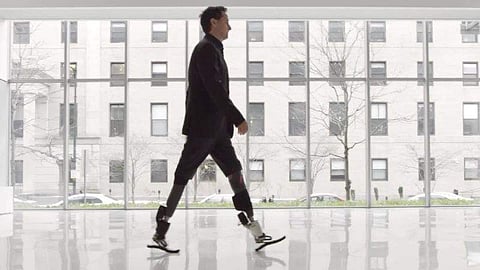Meet the Bionic Man who's a ray of hope for people with disabilities
Among the futuristic innovators, Hugh Herr is sort of a legend. Billed as a "Bionic Man", Herr lost both his legs below the knees to frostbite during a climbing accident in New Hampshires White Mountains in the early 1980s.
A doctor told him he would never climb again. Defiant, Herr used a local machine shop to hack together custom prostheses from rubber, metal and wood. He went on to become a successful climber. The legend today is busy creating bionic limbs at the MIT Biomechatronics lab that emulate the function of natural limbs.
Despite being a double amputee himself, his breakthrough advances in bionic limbs provide greater mobility and new hope to those with physical disabilities. "I viewed the missing biological part of my body as an opportunity, a blank palette for which to create," he said during the 2015 "Autodesk University" conference.
Co-director of the MIT Center for Extreme Bionics as well as Founder of BionX Inc, Herr has heralded a new bionic age, which was visible to the audience at the recently-concluded "Science in the Age of Experience" conference in Boston this month, organized by the 3DExperience French major Dassault Systemes.
Herr's inventions have been named to TIME Magazine "Top Ten Inventions list -- "Rheo", a computer-controlled knee prosthesis which is outfitted with a microprocessor that continually senses the joint's position and the loads applied to the limb and "EmPower", a powered ankle-foot prosthesis which emulates the action of a biological leg and, for the first time, provides amputees with a natural gait.
"Today's leading innovation-led companies are calling for a brand new vision to address the world's many sustainability challenges with a truly holistic scientific and business approach," said Patrick Johnson, VP, R&D, Research & Technology Strategy, Dassault Systèmes.
"We hope to expand our horizons, go beyond borders and experience scientific innovation at large," he added. For Herr, bionic innovation has already begun. The charismatic leader wears two next-generation prosthetic legs, each barely visible under the "cuff of his grey slacks, which produce a faint percussive buzz with each footfall, like the sound of a tiny electric drill".
The sound serves almost as a leitmotif - you hear it, faintly, as he ascends the stairs to his office in the glass-and-metal MIT Media Lab or as he ambles across the stage during a conference.
A team of MIT researchers under his guidance recently showed that nerves made to express proteins that can be activated by light can produce limb movements that can be adjusted in real-time, using cues generated by the motion of the limb itself.
The technique leads to a movement that is smoother and less fatiguing than similar electrical systems that are sometimes used to stimulate nerves in spinal cord injury patients and others.
"Artificial electrical stimulation of muscle often results in fatigue and poor controllability. In this study, we showed mitigation of these common problems with optogenetic muscle control," said Herr, who led the research team. "This has great promise for the development of solutions for patients suffering from debilitating conditions like muscle paralysis."
For amputees, robotic limbs that move like the real thing and are controlled by the mind are a game-changer. The "smart limbs" being developed at the Massachusetts Institute of Technology are possible because of the "Ewing Amputation". The procedure developed between MIT and Brigham and Women's Hospital protects the nerves and muscles so the limb can continue to communicate with the brain, reports CBS-Boston.
"So being both the scientist and the user I have advantages that other people don't have," said Herr, who helped develop the surgery and is leading the development of the robotic limbs. "My legs are basically power tools. So I go home at night, I put my batteries in to a charger."
Herr uses a form of robotic limbs but what's different about the "smart limbs" is that the "Ewing Amputation" allows the brain to control the machine. "So when we did our first human patient and we put the bionic limb on him and we saw natural movements emerged, emerging through the mechatronics in natural ways it was truly exhilarating," Herr noted. "My personal experience underscored for me how poorly designed the world is," he says, "and the profound human suffering that's caused by bad design."


